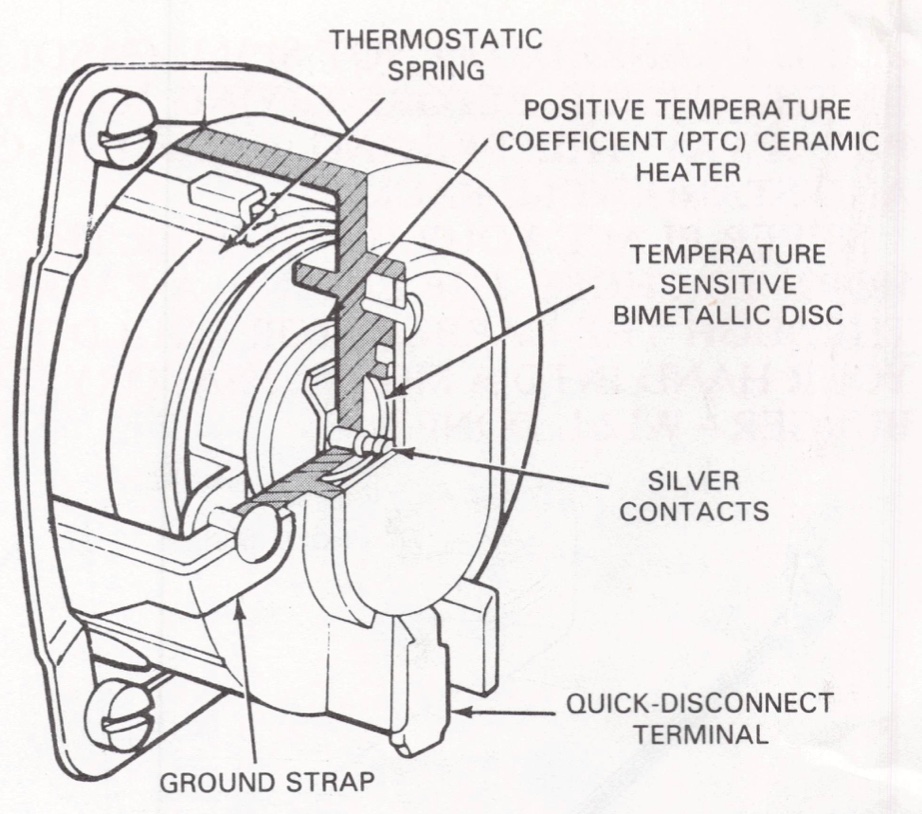We will not discuss the manual choke here.
There are several types of chokes used on carburetion systems.
- Integrated heat choke mounted to the carburetor body
- Divorced heat choke mounted to the manifold
- Integrated electric choke mounted to the carburetor body
- Electric choke conversions available for both integrated and divorced choke systems
Choke Operation
The choke shaft and valve extends through the carburetor into the choke housing. The housing contains a thermostatic coil spring which will wind and unwind as heat is applied. One end of the spring is attached to the housing cover and the other end is attached to a lever on the choke shaft. When it is cold, the coil will hold the choke valve in the closed positiion. When the coil is hot, it will lose its tension and allow the choke valve to open. Once in a while we run into a choke coil that rotates in a direction that appears to be ‘backwards’, it isn’t wrong, just different.
A vacuum operated piston is connected to the choke shaft. As soon as the engine starts, the vacuum will pull on the piston and cause it to attempt to open the choke valve against the pull of the thermostatic coil.
The choke has two levels of operation, start up and cruise.
The choke shaft does not grasp the choke valve in the center, but is positioned so that it is slightly off center. When the engine starts, the velocity of air trying to enter the carburetor will push more on the long side and partially open the valve. A small inlet valve is sometimes placed in the choke valve to admit extra air.
When the engine cold starts, air entering the carburetor will open the valve slightly. The vacuum piston will also pull to open the choke valve slightly and between thet wo they will be able to offset the pull of the coil and open the valve enough to permit the engine to run.
If the throttle is pressed and the engine accelerated, the vacuum pull on the piston will diminish and allow the choke valve to close more tightly and enrich the mixture.
When the engine starts, slots or grooves in the walls of the choke piston cylinder are uncovered which open up inside the choke housing. A choke tube runs from the choke housing down to the exhaust manifold where it enters a heating compartment, also referred to as the ‘choke stove.’
With the engine running, the vacuum will draw air through the tube from the stove up and around the thermostatic coil. As the engine heats up, the air passing the tube becomes hotter and heats the coil. The coil will release tension on the choke valve, allowing it to start to open. When the engine is fully heated up, the coil tension is so weak that the piston and passing air keep the valve fully open.
When the engine stops, the coil cools off and closes the choke ready for the next startup.
In case the carburetor ‘floods the engine’ ie the mixture is too rich, use is made of a choke unloader, an additional lever attached to the choke shaft. If this happens the throttle valve is opened all the way, causing linkage from the throttle lever to strike the unloader trip lever and open the choke to allow air to enter the cylinders.
When the engine is warming up it is necessary to idle the engine somewhat faster to prevent stalling. This is accomplished by connecting the choke shaft to a fast idle cam.
When the choke is on, the fast idle cam swings out in front of the throttle idle speed adjustment screw. This holds the throttle partially open to speed up the engine. As the choke opens, the fast idle cam springs down and the throttle returns to its regular hot idle postion. The fast idle cam is sometimes curved with notches as shown in the image above.
This carburetor shows a typical integrated choke setup.
Cross section of an integrated heat choke
Cross section of an integrated electric choke
This shows a typical divorced choke setup
We currently have available electric choke conversion kits. These can be used on either integrated or divorced heat choke systems. They use a 12v key-on power source and are an excellent replacement.











